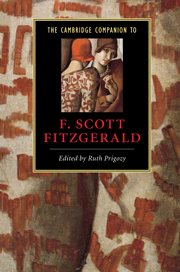Book contents
- Frontmatter
- 1 Introduction: Scott, Zelda, and the culture of celebrity
- 2 F. Scott Fitzgerald, age consciousness, and the rise of American youth culture
- 3 The question of vocation in This Side of Paradise and The Beautiful and Damned
- 4 The short stories of F. Scott Fitzgerald
- 5 The Great Gatsby and the twenties
- 6 Tender is the Night and American history
- 7 Fitzgerald’s expatriate years and the European stories
- 8 Women in Fitzgerald’s fiction
- 9 Fitzgerald’s nonfiction
- 10 Fitzgerald and Hollywood
- 11 The critical reputation of F. Scott Fitzgerald
- Bibliography
- Index
8 - Women in Fitzgerald’s fiction
Published online by Cambridge University Press: 28 May 2006
- Frontmatter
- 1 Introduction: Scott, Zelda, and the culture of celebrity
- 2 F. Scott Fitzgerald, age consciousness, and the rise of American youth culture
- 3 The question of vocation in This Side of Paradise and The Beautiful and Damned
- 4 The short stories of F. Scott Fitzgerald
- 5 The Great Gatsby and the twenties
- 6 Tender is the Night and American history
- 7 Fitzgerald’s expatriate years and the European stories
- 8 Women in Fitzgerald’s fiction
- 9 Fitzgerald’s nonfiction
- 10 Fitzgerald and Hollywood
- 11 The critical reputation of F. Scott Fitzgerald
- Bibliography
- Index
Summary
F. Scott Fitzgerald is best known as a chronicler of the 1920s and as the writer who, more than any other, identified, delineated, and popularized the female representative of that era, the flapper. Though it is an overstatement to say that Fitzgerald created the flapper, he did, with considerable assistance from his wife Zelda, offer the public an image of a modern young woman who was spoiled, sexually liberated, self-centered, fun-loving, and magnetic. In Fitzgerald's mind, this young woman represented a new philosophy of romantic individualism, rebellion, and liberation, and his earliest writings enthusiastically present her as an embodiment of these new values. Although she is often seen now as a mere fashion of the bygone Jazz Age, the flapper should be regarded as one of the great authentic characters in American history. A virtual emblem of American modernity, she and all she stood for were envied, desired, feared, and emulated throughout much of theWestern world, and it was Fitzgerald's particular version of the flapper that “women imitated for more than four decades” (Solomon, Ain't We Got Fun?, 22).
Fitzgerald’s early and widely publicized association with the flapper, however, has led many readers to misconstrue and to oversimplify the author’s portraits of women and of relations between the sexes. It is important to understand that, almost from the start, Fitzgerald was ambivalent toward his “creation,” fearing that the flapper embodied not freedom but moral anarchy and lack of direction. Increasingly he used her as a symbol not only of a new order, but also of social disorder and conflict. As he wrote to Edmund Wilson in May 1925, “If I had anything to do with creating the manners of the contemporary American girl I certainly made a botch of the job” (Life in Letters, 110).
- Type
- Chapter
- Information
- The Cambridge Companion to F. Scott Fitzgerald , pp. 143 - 163Publisher: Cambridge University PressPrint publication year: 2001
- 4
- Cited by



